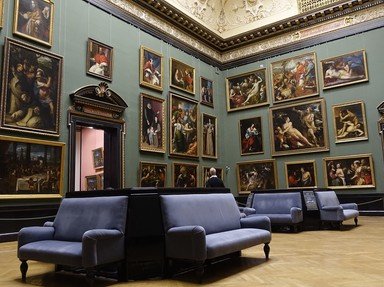Quiz Answer Key and Fun Facts
1. Painted in the late 1590s, "Saint Martin and the Beggar" is a magnificent oil on canvas by one of the greatest painters, sculptors and architects of the Spanish Renaissance period. A smaller version of this painting can also be seen at the Art Institute of Chicago. Who is the artist?
2. Our first look at work from the American Collection is "The White Cloud, Head Chief of the Iowas", an oil on canvas from the mid-19th century. The artist is a painter, author and traveller who specialized in portraits of Native Americans, and was the first white man who travelled west to paint the Plains Indians. Who is this artist?
3. Painted in 1888, "Breton Girls Dancing, Pont-Aven" is part of the collection belonging to Mr. and Mrs. Paul Mellon that is displayed at the National Gallery. A painter, sculptor, printmaker, ceramist and writer, the artist was a significant part of the late-19th century Symbolist movement in France. Who is this Post-Impressionist artist?
4. Painted in 1873, "The Biglen Brothers Racing" is a work by one of the most important painters in American art history. An artist who produced hundreds of portraits, he is also known for his outdoor paintings of people in motion such as the one featured here. Who is this artist?
5. Painted in 1872-73, "The Railway" is a work by a key figure in the transition from Realism to Impressionism. One of the first artists to depict modern life, his early masterworks are now considered a watershed that marks the beginnings of modern art. Who is this artist?
6. Painted in 1893-94, "The Boat Ride" is a work by an American artist who lived mostly in France and exhibited with the early Impressionists. Many of her paintings depict the social and private lives of women, and particularly mothers and children. Who is this artist?
7. This 1909 painting, "Jungle at the Equator", is one of the last works by a French Post-Impressionist who was ridiculed during his lifetime but later became recognized as a self-taught genius. Although he never travelled outside of France, many of his best-known paintings depict jungle scenes such as the one pictured here. Who is this artist?
8. Painted in 1782, "The Skater (A Portrait of William Grant)" is an early work by an American artist who began exhibiting at the Royal Academy just five years earlier. On of America's most important portrait painters, by far his best-known work is his unfinished portrait of George Washington that has been used on the US $1 bill for more than a century. Who is this artist?
9. One of the most famous works on display at the National Gallery of Art is the pictured "Self Portrait" dating to 1889. Although this artist's working life lasted little more than a decade, he left behind a huge volume of work, including numerous self-portraits. Who is this iconic Post-Impressionist artist?
10. Painted in 1775-76, "Portrait of Colonel Guy Johnson" is a work by an American-born painter who became the second President of the prestigious Royal Academy. He is particularly known for his paintings of historical scenes depicting events during the American War of Independence. Who is this artist?
Source: Author
EnglishJedi
This quiz was reviewed by FunTrivia editor
looney_tunes before going online.
Any errors found in FunTrivia content are routinely corrected through our feedback system.
